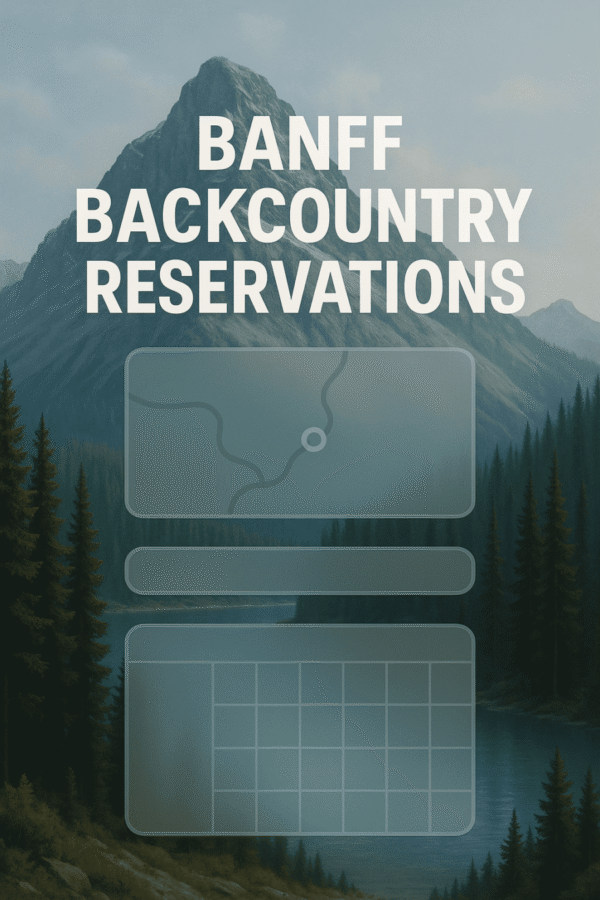Banff Backcountry Reservations: Your Complete Guide to Booking Adventure
📘 Table of Contents
When Do Banff Backcountry Reservations Open Each Year?
Banff backcountry camping reservations typically open in late January at exactly 8:00 a.m. Mountain Time, marking one of the most competitive booking days in Canadian outdoor recreation.
- System Launch: The online reservation system becomes fully operational at 8:00 a.m. sharp, providing access to all 51 backcountry campgrounds across Banff, Yoho, and Kootenay National Parks for the entire year.
- Queue Management: Parks Canada uses a randomized waiting room system to manage the massive demand, so don’t panic if you’re not first in line – everyone has an equal chance regardless of when they logged in during the 30-minute pre-launch window.
- Year-Round Booking: Unlike the previous system that only allowed bookings three months in advance, you can now reserve campsites for any dates throughout the year, giving you unprecedented planning flexibility.
- Phone Alternative: If online booking fails, you can call the Banff Visitor Centre at 403-762-1556 or Lake Louise at 403-522-1264, though expect extremely busy phone lines on launch day.
The new online system launched because overnight backcountry use has increased about 50 percent in recent years, making Banff backcountry reservations absolutely essential for securing your preferred dates and locations.
How Do You Make Banff Backcountry Reservations Successfully?
Making Banff backcountry reservations requires strategic planning and understanding the Parks Canada online system, which operates 24/7 once launched and streamlines the entire booking process.
- Account Setup: Create your Parks Canada account well in advance if you haven’t made a reservation since before March 3, 2023. You can sign in using Facebook, Google, participating banks, or GCKey for secure access.
- Reservation Process: Click the ‘Backcountry’ tab, select ‘Backcountry Zone’, choose your national park (Banff, Kootenay and Yoho Backcountry), set arrival date, party size, and tent pads needed.
- Access Points: You must know your trailhead name – for example, to access Skoki from Lake Louise, you’ll select “Fish Creek” as your access point. A good trail guide or online research helps here.
- Building Your Itinerary: Add campgrounds to your trip one at a time, selecting entry points, number of nights, and available zones. The system shows real-time availability and allows flexible trip planning.
The online system shows exactly what’s available and prevents the frustration of calling busy visitor centres, though you’ll still need to contact them directly for random camping permits or campgrounds not available online. Many backcountry adventurers find this detailed system much more user-friendly than the old phone-only method, despite the competitive nature of opening day.
What Are the Current Costs for Banff Backcountry Permits?
Understanding Banff backcountry reservation fees helps you budget properly for your wilderness adventure, with costs varying based on booking method and additional services required.
- Reservation Fees: A non-refundable $11.50 reservation fee applies for online bookings, while phone reservations cost $13.50. This fee covers the operating costs of the reservation service and mandatory safety orientation.
- Backcountry Camping: Backcountry camping costs $13.50 per person per night, charged for each individual in your group regardless of tent arrangements.
- Cancellation Costs: Cancellations incur the original non-refundable reservation fee plus an additional cancellation fee ($11.50 online or $13.50 by phone). Cancel more than three days before arrival to avoid first-night camping fees.
- Park Entry Requirements: You must also have a valid National Park Pass to enter Banff National Park. Check Parks Canada’s website for current daily and annual pass pricing, as rates are subject to change.
Group size restrictions apply with maximum 10 campers or 5 tent pads per Banff backcountry reservations, and maximum 4 campers per individual tent pad. The all-inclusive fee structure means you’ll know your exact costs upfront, making budget planning straightforward for your backcountry expedition.
What Types of Banff Backcountry Reservations Are Available?
Banff offers diverse backcountry camping options ranging from established campgrounds with amenities to primitive random camping areas, each requiring different permits and offering unique wilderness experiences.
- Designated Campgrounds: Banff has 51 backcountry campgrounds spread across the park, most featuring tent pads, food storage systems (bear poles or lockers), and established facilities. These require advance reservations through the online system.
- Random Camping: Random camping is permitted in designated areas only, requiring camps to be at least 5 km from trailheads or designated campgrounds. These permits must be obtained in person at visitor centres or by calling 403-762-1556 (Banff) or 403-522-1264 (Lake Louise).
- Zone Reservations: Unlike specific site bookings, backcountry zone reservations hold a spot in your selected campground, but tent pad selection operates on first-come, first-served basis upon arrival.
- Mountaineering Bivouacs: Mountaineers require backcountry permits for bivouacking and may only do so in non-vegetated areas, with permits obtained in person at visitor centres.
The variety of camping styles means every adventurer can find their perfect backcountry experience, from families wanting established amenities to experienced wilderness travelers seeking remote solitude. Understanding these Banff backcountry reservations options helps you choose the right type of permit and camping style for your skill level and adventure goals.
What Do You Need for Your Backcountry Permit and Trip?
Proper preparation for your Banff backcountry adventure requires specific permits, gear, and documentation to ensure both legal compliance and safety in the wilderness.
- Permit Documentation: Campers must carry their backcountry permit (paper copy or screenshot) and present it to Parks Canada staff when requested. Your confirmation letter serves as your official permit for most backcountry areas.
- Group Information: All hikers’ names must be included in the reservation, a safety requirement that helps wardens conduct emergency evacuations and accountability checks if needed.
- Vehicle Registration: Ensure your vehicle information is updated in your reservation before arriving at the park, as this helps with parking enforcement and emergency contact procedures.
- Duration Limits: Maximum stay at individual campgrounds is 3 nights, except for Maligne Pass Trail campgrounds which allow only 1 night, encouraging circulation and fair access to popular areas.
For random camping specifically, permits cannot be obtained online and require in-person visits to visitor centres or phone calls, adding an extra planning step but providing personalized route advice from experienced Parks Canada staff. This system ensures you receive current trail conditions and safety information before heading into remote areas. Consider exploring established campgrounds like Ribbon Falls for your first backcountry experience to get familiar with the permit system.
Which Banff Backcountry Areas Book Up Fastest?
Understanding which Banff backcountry destinations fill up immediately helps you prioritize your booking strategy and consider alternative locations that offer equally stunning experiences.
- Egypt Lake: This classic alpine destination consistently sells out within hours of reservations opening, featuring pristine lakes, mountain views, and established campgrounds that make it perfect for both beginners and experienced backpackers.
- Skoki Lodge Area: The historic Skoki region, accessible via Fish Creek trailhead, offers incredible alpine meadows and mountain hut accommodation options, making it extremely popular for multi-day adventures.
- Rockwall Trail (Kootenay): The Rockwall Trail campgrounds should be booked first in separate reservations to maximize success chances, as this spectacular high-alpine traverse ranks among Canada’s premier backpacking experiences.
- Lake O’Hara (Yoho): Lake O’Hara uses a random draw system with applications typically accepted in March, limiting total day-use visitors during the summer season to protect this fragile alpine environment.
The key to success lies in having multiple backup plans and flexible dates. Popular areas book fastest because they offer the perfect combination of accessibility, scenery, and established facilities. However, Banff’s backcountry contains dozens of lesser-known gems that provide equally incredible experiences without the intense competition for Banff backcountry reservations, making research and flexibility your best tools for securing amazing wilderness adventures.
What Are the Bear Safety Requirements for Banff Backcountry?
Bear safety protocols in Banff’s backcountry are mandatory and strictly enforced, designed to protect both wildlife and visitors in one of North America’s most active bear habitats.
- Food Storage: Bear-resistant food containers are mandatory between April 1 and November 15 for random camping areas. Designated campgrounds typically provide food lockers or bear poles for secure storage.
- Campsite Setup: Random campers must pitch tents at least 50 metres from trails and 70 metres from water sources, with cooking and food storage well away from sleeping areas.
- Group Restrictions: Certain areas like Paradise Valley may require mandatory group sizes of 4+ people during high bear activity periods, with violations carrying $25,000 fines for non-compliance.
- Reporting Requirements: All bear, cougar, wolf, and coyote encounters must be reported to Banff Dispatch at 403-762-1470 when safe to do so.
The approved list of bear-resistant food containers changes regularly, so verify current requirements before your trip. Many experienced Banff backpackers recommend carrying bear spray, making noise on trails, and understanding proper food storage techniques regardless of the specific area you’re visiting. These requirements aren’t just bureaucratic rules – they’re essential for preventing dangerous wildlife encounters and protecting Banff’s incredible bear populations.
For an excellent introduction to backcountry bear safety protocols, check out the Running Rain Lake area, where proper food storage techniques are essential for a safe and successful wilderness experience.
What If Your Banff Backcountry Reservations Fall Through?
Missing out on your preferred Banff backcountry reservations doesn’t mean your wilderness adventure is over – several excellent alternatives and strategies can still deliver incredible mountain experiences.
- Cancellation Monitoring: Set up your Parks Canada account early and watch for updates and cancellations. Popular Banff backcountry reservations often become available as trip dates approach and people’s plans change.
- Flexible Dates: Midweek bookings and shoulder season dates (May-June, September-October) typically have better availability than peak summer weekends, often with added benefits like fewer crowds and increased wildlife activity.
- Alternative Accommodations: Consider staying at properties like Baker Creek by Basecamp on the Bow Valley Parkway, which offers cabin-style accommodations close to major trailheads for day hiking access.
- Provincial Parks: Kananaskis Provincial Parks offer excellent backcountry camping with $12 per person/night fees plus $12 reservation fees, providing similar mountain experiences with different booking systems.
The Canadian Rockies extend far beyond Banff’s boundaries, with Kananaskis Country, provincial parks, and other national parks offering equally stunning wilderness experiences. Properties like Basecamp Resorts provide comfortable bases near major recreation areas, letting you enjoy mountain adventures without compromising on rest and comfort. Sometimes the best adventures happen when plans change, leading you to discover hidden gems you never would have found otherwise!
Conclusion
Securing Banff backcountry reservations requires strategic planning, flexibility, and understanding the competitive online booking system that typically launches in late January each year.
From the mandatory bear safety protocols to reservation fees and group size limits, every detail matters for a successful wilderness adventure. Whether you’re targeting popular destinations like Egypt Lake or exploring hidden gems in Banff’s vast backcountry network, proper planning for your Banff backcountry reservations and backup strategies ensure you’ll experience the Canadian Rockies’ incredible wilderness.
Ready to start planning your ultimate Banff backcountry adventure? Check Parks Canada’s website for current year reservation dates, set up your account, and prepare for one of the most rewarding wilderness experiences in North America!
Sources
This article was researched using information from the following authoritative sources:
- Parks Canada – Plan Your Visit
- Parks Canada Reservation Service
- Banff National Park – Backcountry Camping
- The Great Divide Trail Association – Reservation Instructions
- Basecamp Resorts – 2025 Parks Canada Reservations Guide
- Canadian Rockies Trail Guide
- Happiest Outdoors – BC Backcountry Reservations
Affiliate Disclosure
Some links in this post may be affiliate links. As an Amazon Associate and partner with other programs, I may earn a commission if you make a purchase, at no extra cost to you. I only recommend tools and gear I believe in.

